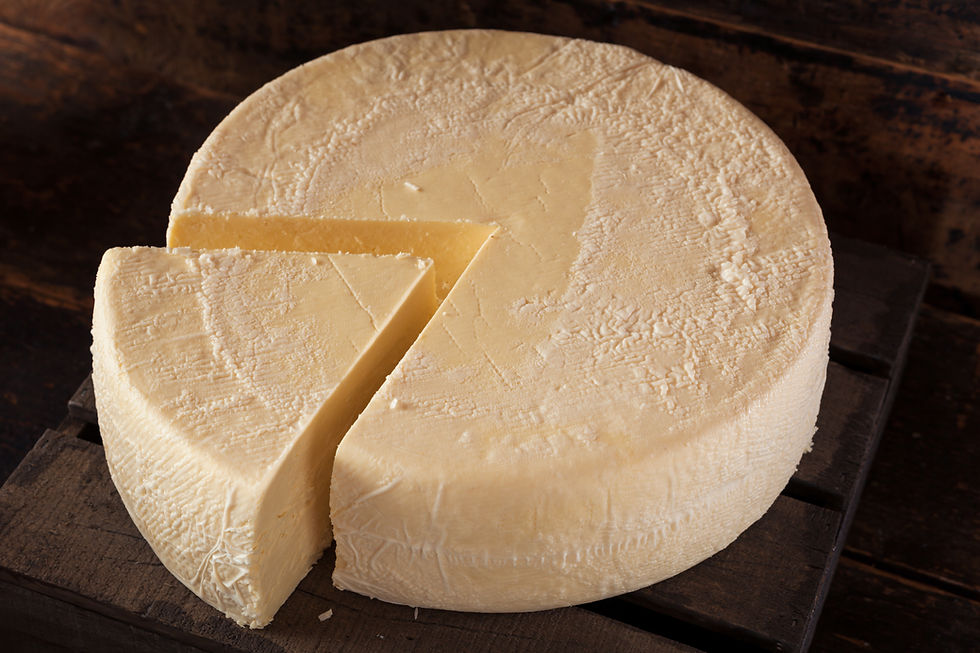B. Linens Bacterium: Big Cheese of B.O.
- Sylvia Rose

- Nov 13, 2024
- 4 min read
Updated: Nov 21, 2024
Brevibacterium linens is a remarkable microorganism on a mission to spread its pungent aroma everywhere, from the unique bite of cheese to most horrific of foot and body odors. It busily produces these through natural processes of fermentation and decomposition.

What is Brevibacterium linens?
Brevibacterium linens is a Gram-positive, rod-shaped bacterium of the Brevibacteriaceae family. It's especially fond of dairy products. This bacterium is also a member of the natural microbial community of human skin. In both roles it uses powerful fermentation processes.
A unique metabolism helps it thrive in different environments. Optimal temperature growth is 20–30 °C. B. linens doesn't form spores and is found in oxygen-rich (aerobic) settings. Famous in cheese making, it creates flavor and texture of cheeses like Limburger and Munster.

Natural Environment
B. linens is commonly found in the natural environment, residing in soil, diverse types of water and on human and animal skin surfaces, especially moist areas like between toes. In nature, these bacteria are decomposers of organic matter, providing nutrients back to the ecosystem.
Besides its ecological role, B. linens enjoys popularity in the dairy industry. It's deliberately introduced into certain types of cheese to create distinctive flavors and textures. It creates complex biological changes during aging.
B. linens enhances flavor and character of ripened cheeses but that's not all. It also helps control the growth of other bacteria by creating conditions to inhibit the undesirable species.

Smell of Cheese
The pungent odor of cheeses like Limburger or Munster comes from compounds produced by B. linens. The bacterium thrives on the surface of the cheeses and ferments proteins and lipids, transforming them into nutritional elements and exuding bacterial body waste.
Fermentation is critical in cheese production. In cheese ripening, B. linens metabolizes lactose and carbohydrates found in milk. This breakdown releases several volatile compounds, including sulfur-containing substances, fatty acids, and ammonia.
The compounds create the powerful aroma of certain cheeses. Isovaleric acid, a fatty acid produced from the breakdown of leucine, is a major contributor to the strong smell. Cheese owes much of its scent to this bacterium's activity during its aging process.

Foot & Body Odor
Brevibacterium linens is also a natural inhabitant of human skin, particularly in areas warm and moist, such as between toes. Here, it feeds on sweat and oils produced by the skin. It metabolizes these substances as energy and releases volatile compounds.
B. linens colonizes the skin in regions of intense perspiration. It begins to break down sweat and dead skin cells. It primarily consumes amino acids and fatty acids found in sweat.
This produces sulfur compounds, organic acids, and alcohols which contribute to the reek.
The organic compound trimethylamine, for instance, is a notable contributor to of foot odor. The byproducts created during this process also include volatile organic compounds like isovaleric acid, leading to the characteristic "cheesy" foot odor.

Isovaleric acid occurs naturally and can be found in many foods, such as cheese, soy milk, and apple juice. Its name comes from the medicinal plant valerian (Valeriana officinalis) as it shares its characteristic smell with valeric acid.
Other Uses of B. linens
Beyond its role in cheese production and contributing to body odor, B. linens has several other fascinating applications.
Biotechnology: Due to its well-characterized enzymes, researchers are investigating its potential in biotechnological applications, such as bioengineering processes that require specific enzyme activities.
Probiotics: Some strains of B. linens are being explored for their potential probiotic properties, although specific research is ongoing.
Environmental Engineering: B. linens may have applications in bioremediation processes due to its ability to break down organic materials, which could help in waste treatment and environmental cleanup initiatives.
In Research: Study of B. linens provides insights into microbial communities and their interactions. Understanding its role on human skin can lead to more effective treatments for body odor management.

Facts About Brevibacterium linens
Morphology: B. linens is rod-shaped, typically measuring between 0.5 to 1 micron in width and 1 to 6 microns in length.
Metabolism: it performs fermentative metabolism, using carbon sources including lactose.
Pathogenicity: Generally recognized as non-pathogenic; however, it can occasionally be associated with skin conditions and infections in immunocompromised individuals.
Culinary Connection: Brevibacterium linens is first isolated from Limburger in the 19th century. It's vital to ripening of washed-rind cheeses and produces distinctive flavors and aromas. Cheeses featuring B. linens are often sold at premium prices in most specialty cheese shops.

Adaptability: It can thrive in various conditions, including high salinity and temperature fluctuations, demonstrating its resilient nature.
Pioneer in Microbial Studies: Its unique properties make B. linens a subject of interest in food microbiology and skin microbial research.
Footwear Dilemma: Ironically, while it enhances cheese, B. linens is notorious for causing foot odor. Avoid polyester socks, change socks after working or playing hard, and never, ever use cornstarch to combat foot odor. To these bacteria it's a delightful snack, inspiring them to proliferate and elevate the stench level.

Brevibacterium linens is a remarkable bacterium that bridges the gap between culinary arts and biology. From cheese to foot odor, B. linens makes itself known. As understanding of bacteria grows, so do possibilities for practical applications.
Non-Fiction Books:
Fiction Books:
READ: Lora Ley Adventures - Germanic Mythology Fiction Series
READ: Reiker For Hire - Victorian Detective Murder Mysteries


